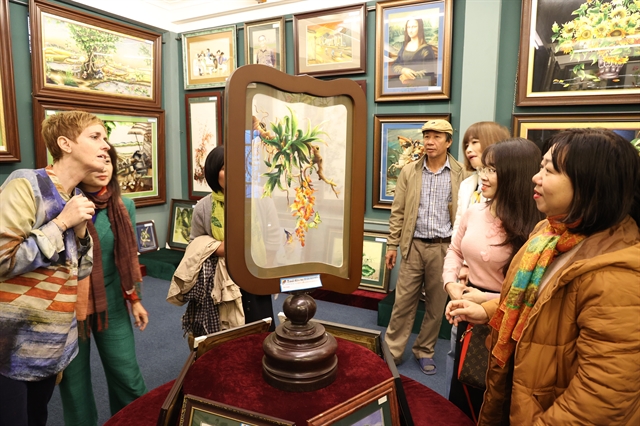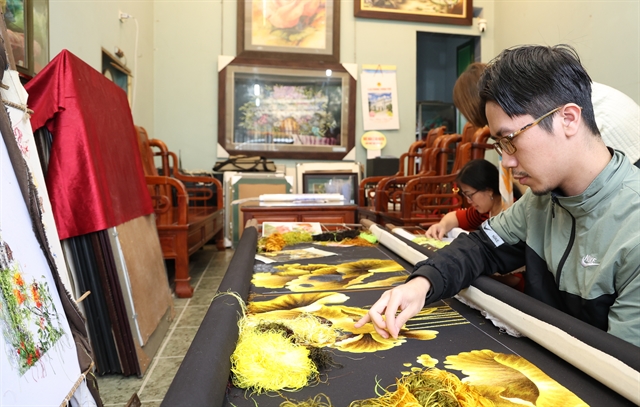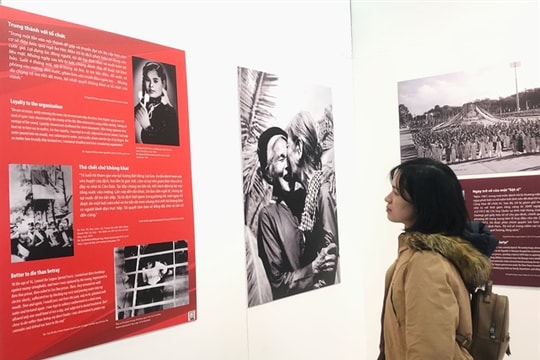 |
| Emeritus Artisan Lê Văn Nguyên, President of Thường Tín Embroidery Association takes tourists to explore the traditional craft in Quất Động Village. Photos courtesy of Hà Nội Department of Agriculture and Rural Development |
HÀ NỘI — Located in Thường Tín District, about 23km from Hà Nội’s centre, Quất Động Village is popular for its handmade embroidered products. Over hundreds of years, the traditional embroidery village has been preserved and developed by enthusiastic artisans.
Quất Động craft village is known as the cradle of traditional embroidery. Legend has it that the master of the embroidery craft in Quất Động Village was Lê Công Hành (1606-1661).
In 1646, he was sent to China as as King Lê Chấn Tông’s envoy and learned embroidery. He learned the needlework skills and upon his return, he taught the craft to the villagers of Quất Động and neighbouring areas. So he was regarded as the Father of embroidery in Việt Nam. After his death, the villagers built a temple to pay their gratitude to him.
For many years, locals have created new models with a lot of themes, featuring Vietnamese life styles. The embroidery in Quất Động has reached a sophisticated and refined level.
After taking care of the crops, Quất Động Villagers focus on embroidery. Each household has traditional sewing frames and many families are the seventh generation to be engaged in the craft.
 |
| A double-sided embroidery work by Lê Văn Nguyên |
Besides maintaining the craft in households, the village has opened many cooperatives and workshops which gather 200 to 500 skillful craftspeople. Many of them have become well-known artisans in Việt Nam, as well as in the world.
"Currently, Quất Động Village has attracted many tourists including foreigners," said Emeritus Artisan Lê Văn Nguyên, President of Thường Tín Embroidery Association.
"They come to see the craft village and buy embroidery painting. Quất Động paintings have been exported to Japan, South Korea, the US and others. I want Thường Tín artisans to update technology science such as online marketing skills with a view to promote the traditional craft product resume."
Quất Động Embroidery Village is one of the traditional craft villages to be invested into developing for tourism in Hà Nội by with a vision to 2030.
The city authorities are completing Master Plan for Developing Traditional Craft Villages in 2024 -2030 period, vision 2050. This is considered a 'leverage' creating conditions for craft villages to develop sustainably and reach out, associated with preserving traditional values and cultural identities of craft villages. It also contributes to increase income for labourers promoting local socio-economic development in the villages and Hà Nội city too.
"The craft village is a key sector in culture industry developing in Hà Nội," said Nguyễn Văn Chí, Head of Hà Nội Rural Development Sub-Department. "The craft village preservation and development are one of important missions to promote economic and social development in localities. The craft village is a must-see spot to Vietnamese and foreign tourists when they visit the capital of Hà Nội .
"Over the past years, Hà Nội has paid attention to the craft village development policy which puts emphasis on craft training, and projects to support crafts development."
Quất Động embroidery is famous for one-sided hand embroidered items portraying the country’s great personalities and beautiful landscape which are favoured by both domestic customers and foreign friends.
In the early stages, the village’s embroidery techniques were quite simple. Villagers often used naturally dyed colour threads, usually yellow, red, mauve, green and blue, to embroider distiches or decorative patterns on parasols and altar canopies and curtains.
As time went on, the embroidery craft continued to develop. In addition to ordinary coloured threads, embroiderers then used metallic threads and applied more complicated techniques to create ever more sophisticated embroidery patterns.
 |
| As for landscape embroidery, embroiderers must try their best to choose threads of the most appropriate types and shades to add depth and dimension to the embroidered works. . |
Today, apart from age-old embroidery techniques, Quất Động artisans also apply more complicated ones such as double-sided embroidery. It is not an exaggeration to say that when looking at these intricate works, no one can find out where the needle work starts and the endpoint finishes, because all thread knots are completely hidden. Due to its complexity, only skillful artisans can master this technique and double-faced embroidery paintings are considered valuable fine handicraft works.* VNS
* Contributed by Hà Nội Rural Development Sub-Department
























